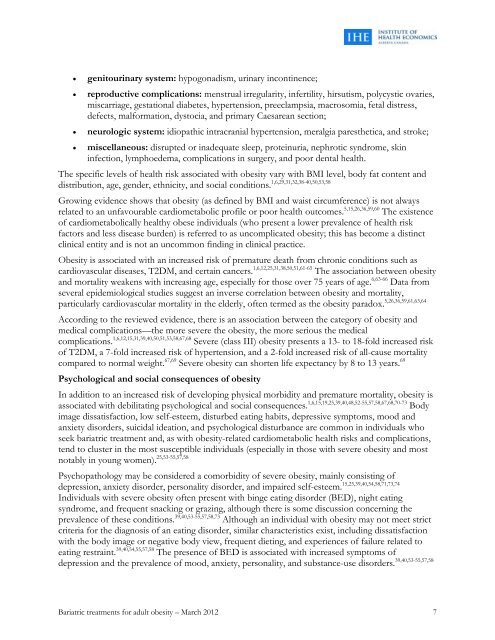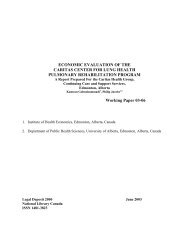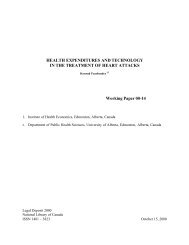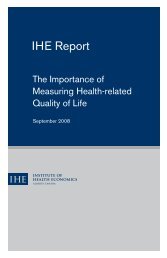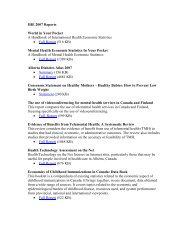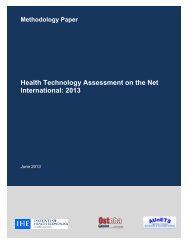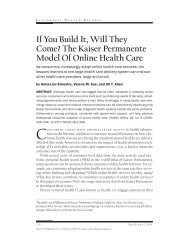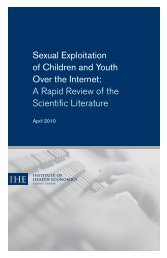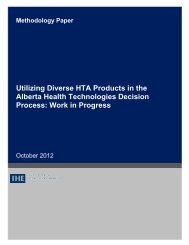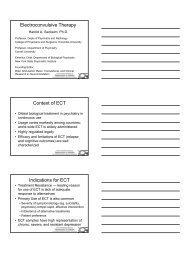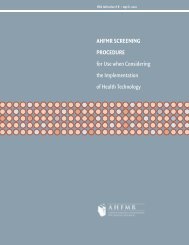Many systemic factors have been identified as <strong>for</strong>ces driving these rapidly occurring changes in<strong>obesity</strong> prevalence. 1,4,6,16,19,23,24,31,38,41-45,47 These factors include modern lifestyles, work environments,urban design and obesogenic (<strong>obesity</strong>-producing) environments, transportation systems, foodproduction systems, technological developments, and economic growth itself. High energy-densitydiets, increased portion sizes, decreased physical activity, and the adoption <strong>of</strong> a sedentary lifestyle, aswell as eating disorders, are considered to be important risk factors in the development <strong>of</strong> <strong>obesity</strong>.However, accurate and reliable data on behavioural, socioeconomic, and other environmentalinfluences on diets and physical activity are still needed <strong>for</strong> clarifying the complex causes andconsequences <strong>of</strong> <strong>obesity</strong>. 4,31,32,43 Most <strong>of</strong> the available data were obtained through survey studiesconducted in North America, Europe, and Australia using various data collection strategies to recordusual dietary intake and frequency <strong>of</strong> physical activity. All the survey measures represent short-termmeasures <strong>of</strong> dietary intake and physical activity, while <strong>obesity</strong> is the result <strong>of</strong> a long-term imbalancebetween energy intake and expenditure. Although the existing social differences between and withincountries constitute evidence that may provide important insights into ways <strong>of</strong> influencing change toprevent and manage <strong>obesity</strong>, caution needs to be exercised in generalizing data from differentsociopolitical contexts.The administration <strong>of</strong> some drugs (such as antidepressants, antiepileptics, antipsychotics,antihypertensive agents, antidiabetic agents, and steroids), and neuroendocrine abnormalities ordiseases (such as hypothalamic, pituitary, thyroid, and adrenal diseases) may lead to or are associatedwith excessive weight gain and may hinder induced weight loss. 1,2,13,19,20,23,24,45,46,48 The hormones thatare believed to be involved in the regulation and pathophysiology <strong>of</strong> <strong>obesity</strong> include insulin,cholecystokinin, and leptin. 23,24 Lack <strong>of</strong> sleep may also contribute to excessive weight gain. 19<strong>Health</strong> risks and complications associated with <strong>obesity</strong>For many individuals, carrying excess body fat and weight, together with other known and unknownfactors, may lead to many cardiovascular and metabolic complications and is associated with manydebilitating health problems. 1,6,10,12,16,19,25,26,32,38-40,47-57 <strong>Health</strong> risks and acute and chronic conditionsassociated with <strong>obesity</strong> include the following:metabolic risks and complications: T2DM, insulin resistance, dyslipidaemia, metabolicsyndrome, hyperuricaemia, gout, and low-grade inflammation;cardiovascular system: hypertension, coronary heart disease, congestive heart failure, andvenous thromboembolism;respiratory system: asthma, hypoxemia, obstructive sleep apnea, <strong>obesity</strong> hypoventilationsyndrome (Pickwickian syndrome), dyspnea, and fatigue;cancers: esophagus, small intestine, colon, rectum, liver, gallbladder, pancreas, kidney,leukaemia, multiple myeloma, and lymphoma, as well as:o in women: endometrial, cervix uteri, ovary, breast cancer after menopause;o in men: prostate cancer, colon, rectum cancer;musculoskeletal system: osteoarthritis (especially knee), immobility, low back pain andpain in the weight-bearing joints, musculoskeletal pain resulting in functional limitations;gastrointestinal system: gallbladder disease, non-alcoholic fatty liver disease, hepaticsteatosis, gastro-esophageal reflux disease, and hernia;<strong>Bariatric</strong> <strong>treatments</strong> <strong>for</strong> <strong>adult</strong> <strong>obesity</strong> – March 2012 6
genitourinary system: hypogonadism, urinary incontinence;reproductive complications: menstrual irregularity, infertility, hirsutism, polycystic ovaries,miscarriage, gestational diabetes, hypertension, preeclampsia, macrosomia, fetal distress,defects, mal<strong>for</strong>mation, dystocia, and primary Caesarean section;neurologic system: idiopathic intracranial hypertension, meralgia paresthetica, and stroke; miscellaneous: disrupted or inadequate sleep, proteinuria, nephrotic syndrome, skininfection, lymphoedema, complications in surgery, and poor dental health.The specific levels <strong>of</strong> health risk associated with <strong>obesity</strong> vary with BMI level, body fat content anddistribution, age, gender, ethnicity, and social conditions. 1,6,29,31,32,38-40,50,53,58Growing evidence shows that <strong>obesity</strong> (as defined by BMI and waist circumference) is not alwaysrelated to an unfavourable cardiometabolic pr<strong>of</strong>ile or poor health outcomes. 5,15,26,36,59,60 The existence<strong>of</strong> cardiometabolically healthy obese individuals (who present a lower prevalence <strong>of</strong> health riskfactors and less disease burden) is referred to as uncomplicated <strong>obesity</strong>; this has become a distinctclinical entity and is not an uncommon finding in clinical practice.Obesity is associated with an increased risk <strong>of</strong> premature death from chronic conditions such ascardiovascular diseases, T2DM, and certain cancers. 1,6,12,25,31,38,50,51,61-65 The association between <strong>obesity</strong>and mortality weakens with increasing age, especially <strong>for</strong> those over 75 years <strong>of</strong> age. 6,63-66 Data fromseveral epidemiological studies suggest an inverse correlation between <strong>obesity</strong> and mortality,particularly cardiovascular mortality in the elderly, <strong>of</strong>ten termed as the <strong>obesity</strong> paradox. 5,26,36,59,61,63,64According to the reviewed evidence, there is an association between the category <strong>of</strong> <strong>obesity</strong> andmedical complications—the more severe the <strong>obesity</strong>, the more serious the medicalcomplications. 1,6,12,15,31,39,40,50,51,53,58,67,68 Severe (class III) <strong>obesity</strong> presents a 13- to 18-fold increased risk<strong>of</strong> T2DM, a 7-fold increased risk <strong>of</strong> hypertension, and a 2-fold increased risk <strong>of</strong> all-cause mortalitycompared to normal weight. 67,69 Severe <strong>obesity</strong> can shorten life expectancy by 8 to 13 years. 69Psychological and social consequences <strong>of</strong> <strong>obesity</strong>In addition to an increased risk <strong>of</strong> developing physical morbidity and premature mortality, <strong>obesity</strong> isassociated with debilitating psychological and social consequences. 1,6,15,19,25,39,40,48,52-55,57,58,67,68,70-73 Bodyimage dissatisfaction, low self-esteem, disturbed eating habits, depressive symptoms, mood andanxiety disorders, suicidal ideation, and psychological disturbance are common in individuals whoseek bariatric treatment and, as with <strong>obesity</strong>-related cardiometabolic health risks and complications,tend to cluster in the most susceptible individuals (especially in those with severe <strong>obesity</strong> and mostnotably in young women). 25,53-55,57,58Psychopathology may be considered a comorbidity <strong>of</strong> severe <strong>obesity</strong>, mainly consisting <strong>of</strong>depression, anxiety disorder, personality disorder, and impaired self-esteem. 15,25,39,40,54,58,71,73,74Individuals with severe <strong>obesity</strong> <strong>of</strong>ten present with binge eating disorder (BED), night eatingsyndrome, and frequent snacking or grazing, although there is some discussion concerning theprevalence <strong>of</strong> these conditions. 39,40,53-55,57,58,73 Although an individual with <strong>obesity</strong> may not meet strictcriteria <strong>for</strong> the diagnosis <strong>of</strong> an eating disorder, similar characteristics exist, including dissatisfactionwith the body image or negative body view, frequent dieting, and experiences <strong>of</strong> failure related toeating restraint. 39,40,54,55,57,58 The presence <strong>of</strong> BED is associated with increased symptoms <strong>of</strong>depression and the prevalence <strong>of</strong> mood, anxiety, personality, and substance-use disorders. 39,40,53-55,57,58<strong>Bariatric</strong> <strong>treatments</strong> <strong>for</strong> <strong>adult</strong> <strong>obesity</strong> – March 2012 7
- Page 1 and 2: Alberta STE ReportBariatric treatme
- Page 3 and 4: Alberta STE ReportBariatric treatme
- Page 5 and 6: EXECUTIVE SUMMARYSocial and System
- Page 7 and 8: Three surgical procedures—adjusta
- Page 9: Costs of Bariatric Surgery and Pote
- Page 12 and 13: Regulatory status .................
- Page 14 and 15: TABLES AND FIGURESSection One: Soci
- Page 16 and 17: ABBREVIATIONSAll abbreviations that
- Page 18 and 19: LYMmMAMDMUHCNANHLBINHSNICENIHNNHNPH
- Page 20 and 21: Bariatric physician: a licensed Doc
- Page 22 and 23: High-density lipoprotein (HDL): a f
- Page 24 and 25: Very-low-calorie diet (VLCD): a die
- Page 26 and 27: Additional Internet searches were c
- Page 28 and 29: This report addresses obesity in ad
- Page 32 and 33: Severe obesity is associated with d
- Page 34 and 35: eport their height and under-report
- Page 36 and 37: Also using self-reported data from
- Page 38 and 39: An examination of overall obesity d
- Page 40 and 41: Table S.2 presents the associationa
- Page 42 and 43: • have multiple focal points and
- Page 45 and 46: The main problem in any weight mana
- Page 47: food, and a negative body image. As
- Page 50 and 51: directly causes death. 61 To the ex
- Page 52 and 53: The addition of a selected pharmaco
- Page 54 and 55: lack of formal training in nutritio
- Page 56 and 57: slightly more likely to have prescr
- Page 58 and 59: selection criteria, have facilities
- Page 60 and 61: Barriers to using appropriate baria
- Page 62 and 63: Overview of adult obesityOver the p
- Page 64 and 65: the need for regular physical activ
- Page 66 and 67: phenylpropanolamine/25. Sibutramine
- Page 68 and 69: Complianceand AdherenceDemand andut
- Page 70 and 71: Aetna Clinical PolicyBulletinswww.a
- Page 72 and 73: Overweight 123,821 172,971 157,623
- Page 74 and 75: REFERENCES1. 2006 Canadian clinical
- Page 76 and 77: 34. Gostin LO. Fast and supersized:
- Page 78 and 79: 69. Klarenbach S, Padwal R, Wiebe N
- Page 80 and 81:
105. Hill JO, Thompson H, Wyatt H.
- Page 82 and 83:
141. Ross R, Bradshaw AJ. The futur
- Page 84 and 85:
172. Arkinson J, Ji H, Fallah S, Pe
- Page 86 and 87:
This section will address a set of
- Page 88 and 89:
dietary therapy is to reduce total
- Page 90 and 91:
Additional benefits of exercise ove
- Page 92 and 93:
medications that inhibit intestinal
- Page 94 and 95:
Rimonabant may be considered for pa
- Page 96 and 97:
Long-term complications are specifi
- Page 98 and 99:
Devices used for bariatric surgeryH
- Page 100 and 101:
Description of the Included Systema
- Page 102 and 103:
AEs for sibutramineAs compared to a
- Page 104 and 105:
Evidence on Efficacy/EffectivenessW
- Page 106 and 107:
Table T.7: Effects of behavioural t
- Page 108 and 109:
SurgeryDescription of the included
- Page 110 and 111:
follow-up time was 3 years. Results
- Page 112 and 113:
group as compared to the VBG group.
- Page 114 and 115:
The authors identified many methodo
- Page 116 and 117:
The investigators pointed out that
- Page 118 and 119:
approximately 3 to 5 kilograms. For
- Page 120 and 121:
for studies with a mean age of part
- Page 122 and 123:
Examining whether use of any of the
- Page 124 and 125:
Evidence from placebo-controlled cl
- Page 126 and 127:
colorectal or gastroesophageal or f
- Page 128 and 129:
Web of ScienceISI Interface License
- Page 130 and 131:
AMA Clinical PracticeGuidelineswww.
- Page 132 and 133:
critical appraisal of the included
- Page 134 and 135:
APPENDIX T.B: EXCLUDED STUDIESTable
- Page 136 and 137:
Padwal R, Li SK, Lau DC. Long-term
- Page 138 and 139:
Quality subsection 1: At least MEDL
- Page 140 and 141:
Quality subsection 5a:Study quality
- Page 142 and 143:
Partially reported: The study types
- Page 144 and 145:
Table T.C.1: Results of quality ass
- Page 146 and 147:
Table T.C.1: Results of quality ass
- Page 148 and 149:
APPENDIX T.D: CHARACTERISTICS OF SY
- Page 150 and 151:
Table T.D.1: Characteristics of the
- Page 152 and 153:
Table T.D.1: Characteristics of the
- Page 154 and 155:
Table T.D.2: Characteristics of the
- Page 156 and 157:
APPENDIX T.E: EVIDENCE TABLE ON SAF
- Page 158 and 159:
Serious surgical complicationsSurgi
- Page 160 and 161:
LSGmMAMDNAnssORQoLRCTRDRRRYGBSBPTGV
- Page 162 and 163:
Table T.F.1-2: Weight loss - Behavi
- Page 164 and 165:
Table T.F.1-4: Weight loss - Surger
- Page 166 and 167:
Table T.F.2: Quality of life (QoL)
- Page 168 and 169:
Curioni & Lourenco 2005 58Cholester
- Page 170 and 171:
Table T.F.3-3: Risk factors/comorbi
- Page 172 and 173:
Table T.F.3-5: Long-term effects of
- Page 174 and 175:
Maciejewski et al., 2005 65Avenell
- Page 176 and 177:
Table T.G.2: Effects of bariatric s
- Page 178 and 179:
Table T.G.4: Effects of bariatric s
- Page 180 and 181:
18. Cerulli J, Lomaestro BM, Malone
- Page 182 and 183:
50. Health Canada Drug Product Data
- Page 184 and 185:
SECTION THREE: ECONOMIC EVALUATIONC
- Page 186 and 187:
Definition of bariatric surgical pa
- Page 188 and 189:
etween surgical interventions, the
- Page 190 and 191:
concluded that adding orlistat to L
- Page 192 and 193:
Weight management program (WMP) ver
- Page 194 and 195:
groups. Compared with standard care
- Page 196 and 197:
Results from Analysis of Provincial
- Page 198 and 199:
DiscussionThe objectives of the eco
- Page 200 and 201:
surgical suites, and so on. The bud
- Page 202 and 203:
APPENDIX E.A: LITERATURE SEARCH SUM
- Page 204 and 205:
CRD Databases(DARE, HTA & NHS EED)h
- Page 206 and 207:
Web of ScienceISI Interface License
- Page 208 and 209:
NEOS Librarywww.library.ualberta.ca
- Page 210 and 211:
Table E.A.2: Evidence table of revi
- Page 212 and 213:
ResultHealth outcomesCostsMarginal
- Page 214 and 215:
CostsMarginal analysisThe cost anal
- Page 216 and 217:
Time Horizon/discount rateCurrency/
- Page 218 and 219:
Objectivestudy perspective: society
- Page 220 and 221:
ResultHealth outcomesCostsMarginal
- Page 222 and 223:
ResultHealth outcomesCostsMarginal
- Page 224 and 225:
S4Economic burden of obesityMean co
- Page 226 and 227:
15. Lacey LA, Wolf A, O'shea D, Ern
- Page 228 and 229:
Author Contribution StatementsPaula


